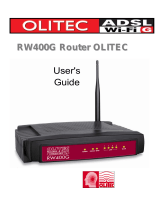
CONTENTS
Package Contents..........................................................................................1
Chapter 1. Introduction .................................................................................2
1.1 Overview of the Router ................................................................................... 2
1.2 Features .......................................................................................................... 2
1.3 Panel Layout ................................................................................................... 3
1.3.1 The Front Panel.................................................................................... 3
1.3.2 The Rear Panel .................................................................................... 3
Chapter 2. Connecting the Router................................................................5
2.1 System Requirements..................................................................................... 5
2.2 Installation Environment Requirements........................................................... 5
2.3 Connecting the Router .................................................................................... 5
Chapter 3. Quick Installation Guide .............................................................7
3.1 TCP/IP configuration ....................................................................................... 7
3.2 Quick Installation Guide .................................................................................. 8
Chapter 4. Configuring the Router .............................................................12
4.1 login .............................................................................................................. 12
4.2 Status ............................................................................................................ 12
4.3 Quick Setup................................................................................................... 13
4.4 Network ......................................................................................................... 13
4.4.1 LAN .................................................................................................... 13
4.4.2 WAN ................................................................................................... 14
4.4.3 MAC Clone ......................................................................................... 19
4.5 DHCP............................................................................................................ 20
4.5.1 DHCP Settings ................................................................................... 20
4.5.2 DHCP Clients List............................................................................... 21
4.5.3 Address Reservation .......................................................................... 21
4.6 Forwarding .................................................................................................... 23
4.6.1 Virtual Servers .................................................................................... 23
4.6.2 Port Triggering .................................................................................... 24
4.6.3 DMZ.................................................................................................... 26
4.6.4 UPnP .................................................................................................. 27
4.7 Security ......................................................................................................... 28
4.7.1 Firewall ............................................................................................... 28
4.7.2 IP Address Filtering ............................................................................ 29
4.7.3 Domain Filtering ................................................................................. 31
4.7.4 MAC Filtering...................................................................................... 32
4.7.5 Remote Management ......................................................................... 33
4.7.6 Advanced Security.............................................................................. 34





















